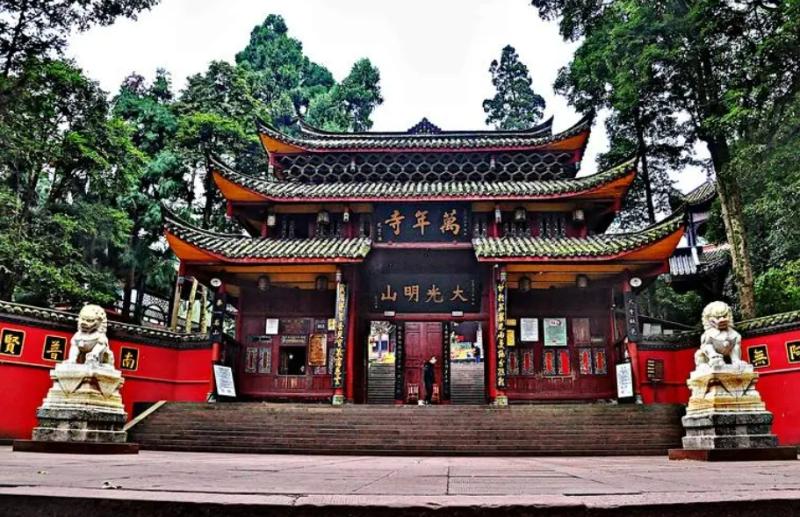Wannian Temple

Mount Emei: Wannian Temple, Illuminated by Buddha's Light, Prosperous with Incense
Mount Emei, known as "the most beautiful mountain in the world," attracts countless tourists with its magnificent and picturesque scenery. Located on the Golden Summit of Mount Emei, Wannian Temple, with its long history, unique architectural style, and profound Buddhist culture, shines like a bright pearl on the mountain.
I. History of Wannian Temple
1. Origin of Buddhist Culture
As one of China's four famous Buddhist mountains, Mount Emei has a long history of Buddhist culture. As early as the 3rd century BC, Mount Emei began to be influenced by Buddhism. Legend has it that as early as the Han Dynasty, monks practiced Buddhism on Mount Emei and built simple temples on the summit.
2. Establishment of Wannian Temple
Wannian Temple was established in 368 AD by Hui Chi, a high-ranking monk of the Eastern Jin Dynasty. According to records, Hui Chi practiced Buddhism on Mount Emei for many years and felt that the summit's beautiful scenery and tranquil environment were perfect for cultivation. He therefore built a temple on the summit, named "Puxian Temple." Later, as the summit was often covered in snow, the temple was always covered in snow, so people renamed it "Wannian Temple," signifying that the temple would remain evergreen for ten thousand years, remaining prosperous with incense for thousands of years.
3. Rise and Fall of Wannian Temple Through the Ages
Wannian Temple experienced several periods of rise and fall during its long history. During the Tang Dynasty, Wannian Temple flourished and became the center of Buddhism on Mount Emei. In the Song Dynasty, Wannian Temple began to decline, and the temple's scale was reduced. During the Ming and Qing dynasties, Wannian Temple was rebuilt, and the temple's scale expanded again. In modern times, Wannian Temple was damaged by war, but it still maintained its basic size.
II. Architectural Features of Wannian Temple
1. Architectural Scale
Wannian Temple is located on the Golden Summit of Mount Emei, at an altitude of 3077 meters, making it the highest temple on Mount Emei. The temple is grand in scale, with a unique architectural style, a typical fusion of Tibetan and Han styles.
2. Main Buildings
The main buildings of Wannian Temple include:
- The Great Buddha Hall: This is the core building of Wannian Temple, housing a statue of Sakyamuni Buddha. It is grand in scale and solemn.
- The Puxian Hall: This hall houses the statue of Puxian Bodhisattva, the guardian deity of Mount Emei. It is the most popular attraction for tourists.
- The Reclining Buddha Hall: This hall houses a massive reclining Buddha statue, one of the most famous attractions in the temples of Mount Emei.
- The Golden Summit Pagoda: This pagoda stands behind the Great Buddha Hall, towering 40 meters high and creating a unique sight on Mount Emei.
3. Architectural Features
Wannian Temple boasts a unique architectural style, blending Tibetan and Han elements. The temple's roof adopts the Tibetan style sloping roof, with exquisite dragon and phoenix carvings adorning the roof ridge. The temple walls are built in the Han style with brick, decorated with exquisite murals.
III. Cultural Significance of Wannian Temple
1. Buddhist Culture
As the center of Buddhism on Mount Emei, Wannian Temple is an important part of the Buddhist culture of Mount Emei. The temple houses a large collection of Buddhist relics, including scriptures, statues, murals, etc., which serve as important testaments to the Buddhist culture of Mount Emei.
2. Puxian Culture
Mount Emei is known as the "Puxian Dojo," and Wannian Temple is an important site for the Puxian culture of Mount Emei. The temple houses the statue of Puxian Bodhisattva, which is a popular destination for countless devotees.
3. Incense at Wannian Temple
Wannian Temple is a popular place of worship, with a large number of tourists visiting every year. Visitors can not only admire the beautiful scenery but also experience the charm of Buddhist culture and gain an understanding of the true meaning of life.
IV. Conclusion
Wannian Temple on Mount Emei is not only a beautiful sight on Mount Emei but also an important symbol of Chinese Buddhist culture. Its unique architectural style, profound Buddhist culture, and prosperous incense attract countless tourists, making it an indispensable part of Mount Emei tourism.